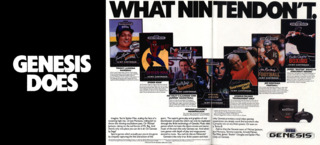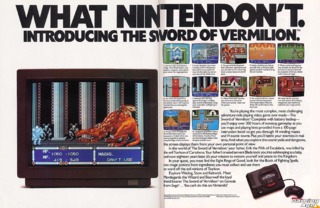Origins
 Genesis does...
Genesis does...The term "Blast Processing" referred to the faster performance of the Genesis. Many assumed that it was referring to the CPU clock rate. While the main Ricoh 5A22 processor of the SNES was clocked at 3.58 MHz, the main 68000 CPU processor of the Genesis was clocked at 7.67 MHz, twice the clock speed of its rival. In addition, the 68000 had a 32-bit internal data bus and 16-bit external data bus, whereas the 5A22 had a 16-bit internal data bus and 8-bit external data bus.
However, the term "Blast Processing" was originally coined in reference to the high-speed DMA unit in Sega's Yamaha VDP graphics processor, which allowed much faster DMA (direct memory access) transfer speeds than the SNES, along with Sega's faster RAM bandwidth. The faster bandwidth and higher fillrate of the Genesis gave it a number of advantages, such as higher resolutions during gameplay, faster and more complex parallax scrolling, fast data blitting, high frame-rate with many moving objects on screen, more tiles and large sprites per frame, and programmable 3D polygon capabilities with the base hardware (without needing any enhancement chips on cartridges). On the other hand, the SNES had its own advantages, such as its CPU having more instructions per clock cycle and higher amount of slower RAM, and its PPU graphics chip having more colors and being capable of a higher static menu resolution, more small sprites on screen, and Mode 7 tilemap scaling and rotation. Similar scaling and rotation effects were possible on the Genesis through DMA programming.
At the height of the 16-bit console war of the '90s, Sega continually attempted to posit its Genesis console (a.k.a. Mega Drive) as the "cooler" one (over the SNES). Sega's advertising campaigns were edgy and confrontational, and "Blast Processing" was one of the many buzzwords coined to aid product differentiation. Sega focused on its biggest advantage, emphasizing the much faster performance of the Genesis in its "Blast Processing" commercials.
Later years
 ... what Nintendon't.
... what Nintendon't.Due to much of the public being generally unaware of what the term was originally referring to in the first place, this later allowed rival Nintendo to paint "Blast Processing" as just a "Myth" without any basis. In 1994, Nintendo published an advertisement entitled "SMASHING The Myth About Speed and Power" in popular video game magazines, presented as a pseudo-editorial piece; while it had the word "advertisement" in very small writing, it was not made clear to readers that it was written by Nintendo, misleading many to believe it was a legitimate editorial piece written by the actual magazines. The piece attacked the "Blast Processing" label while making a number of inaccurate and misleading claims about the Genesis.
Nintendo's counter-campaign was successful, eventually leading to backlash against the "Blast Processing" label and eventually Sega itself. Over the years, the phrase came to be perceived by many to be a gimmick from the '90s. In reality, "Blast Processing" was a simplified laymen's term to refer to the high-speed bandwidth and fillrate of the Genesis VDP graphics processor's DMA unit.
Since much of the public was unaware of the term's origins, many presumed that it was simply referring to the higher clock rate of the CPU, due to a lack of understanding that there is much more to a system's capabilities than just the CPU's clock speed (i.e. MHz) or word length (i.e. bits).
Later generations of marketing campaigns moved onto a similarly simplified approach, with Sony heavily promoting the PS1 and PS2 by focusing on only a single technical aspect, raw polygons per second, often exaggerating it considerably, compared to the more realistic figures usually given by Sega (for the Saturn and Dreamcast) and Nintendo (for the N64 and GameCube). In more recent years, however, the focus has been on resolution, during the PS3/X360 and PS4/X1 eras.
 Hur hur.
Hur hur.Some have applied the term to other similar marketing campaigns. Some nostalgic gamers now recall Blast Processing if a new game/console is marketed as a technological tour de force, and it has also become somewhat of an internet meme. Sega currently self-parodies the phrase when marketing their emulated Genesis releases on the XBOX Live Arcade and other compilations.
External Links
Log in to comment